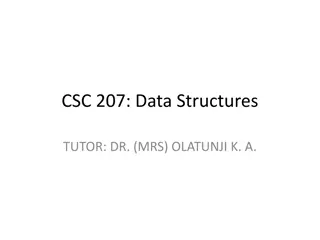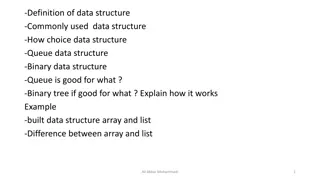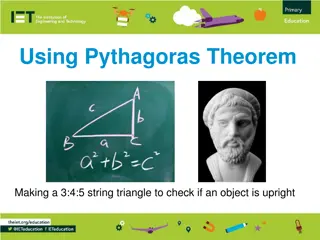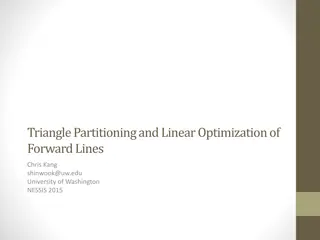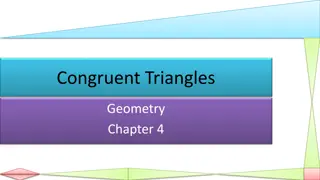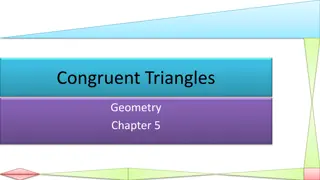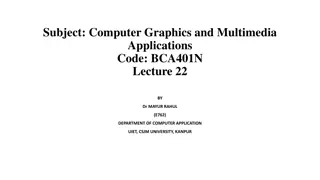Understanding Data Structures in Triangle Meshes
Delve into the data structure of triangle meshes, as explained by Yutaka Ohtake from the Department of Precision Engineering at the University of Tokyo. Explore adjacent vertex and face lists, as well as the construction algorithms for creating these lists. Learn about the implementation methods, laplacian computations, and more in this comprehensive guide to handling triangle mesh data structures.
Download Presentation

Please find below an Image/Link to download the presentation.
The content on the website is provided AS IS for your information and personal use only. It may not be sold, licensed, or shared on other websites without obtaining consent from the author. Download presentation by click this link. If you encounter any issues during the download, it is possible that the publisher has removed the file from their server.
E N D
Presentation Transcript
Data Structure of Triangle Meshes Yutaka Ohtake Department of Precision Engineering The University of Tokyo
Contents Adjacent vertex lists Example of usage : computing Laplacians Adjacent face lists Example of usage : computing vertex normals Face mates Example of usage : linear subdivision 2
Adjacent Vertex Lists (vertex-to-vertices) At each vertex, we store the neighboring vertices. List 0 : {1,5,6,7} List 1 : {5,2,0} (Please complete here) 1 0 2 5 6 7 3 4 8 3
Data Structure Two dimensional array with varying their lengths. int *listSizes; int **adLists; void printAdjacentList(int i){ int size = listSizes[i]; int* list = adLists[i]; for(int j=0; j<size; j++){ printf( %d-th vertex is adjacent to %d-th vertex\n , list[j], i); } } 4
Algorithm of List Construction For each triangle (A, B, C) Append A to B's list Append B to C's list Append C to A's list Actually, the above can not compute the correct lists in some cases. Please indicate such cases. 5
Implementation (For the people who do not like std::vector) 1. Count the size of lists for memory allocation. listSizes = new int[numVertices]; for(int i=0; i<numVertices; i++) listSizes[i] = 0; 2. Construct the list. for(int i=0; i<numTriangles; i++){ int* t = triangles[i]; for(int j=0; j<3; j++) adLists[t[j]][listSizes[t[j]]++] = t[(j+1)%3]; adLists[t[j]][listSizes[t[j]]++] = t[(j+1)%3]; } for(int i=0; i<numTriangles; i++) for(int j=0; j<3; j++) listSizes[triangles[i][j]]++; adLists = new int*[numVertices]; for(int i=0; i<numVertices; i++){ adLists[i] = new int[listSizes[i]]; listSizes[i] = 0; } 6
Computing Laplacians (Re-visited) Using adjacent vertex lists, you can compute Laplacian at a vertex without traversing all triangles. 1 neighbors = p p q ( ) L i # neighbors q i Please re-implement Laplacian smoothing by using adjacent lists 7
Contents Adjacent vertex lists Example of usage : computing Laplacians Adjacent face lists Example of usage : computing vertex normals Face mates Example of usage : linear subdivision 8
Adjacent Face Lists (vertex-to-faces) At each vertex, we store the neighboring triangles. List 0 : {0,4,5} List 1 : {1,0} (Please complete here) 1 0 0 2 1 5 4 2 5 3 6 7 3 6 8 7 4 8 9
Data Structure Same as vertex-to-vertices list. int *listSizes; int **adLists; void printAdjacentList(int i){ int size = listSizes[i]; int* list = adLists[i]; for(int j=0; j<size; j++){ printf( %d-th triangle is adjacent to %d-th vertex\n , list[j], i); } } 10
Algorithm of List Construction For each triangle (A, B, C) Append the triangle ID to B's list Append the triangle ID to C's list Append the triangle ID to A's list Please implement the above. Then re-implement vertex normal computation by using the list for vertex-to-triangles. 11
Contents Adjacent vertex lists Example of usage : computing Laplacians Adjacent face lists Example of usage : computing vertex normals Face mates Example of usage : linear subdivision 12
Face mates (face-to-faces) At each triangle, we store the three triangles sharing the edges. 9 0-th triangle (0,3,1): [4,9,1] 1-st triangle (0,4,3): [2,0,-1] (Please complete here) 0 9 4 1 1 0 3 4 2 5 3 2 8 5 6 8 7 6 7 No mate 13
Algorithm of Mate Construction 1. Construct the adjacent face lists. 2. For the i-th triangle (A,B,C) 1. Set mate for A to the triangle (not i-th) containing B in the C's list 2. Set mate for B to the triangle (not i-th) containing C in the A's list 3. Set mate for C to the triangle (not i-th) containing A in the B's list C i Mate for A A B 14
Implementation int (*mates)[3]; void constructFaceMates(){ constructAdjacentFaceLists(); mates = new int[numTriangles][3]; for(int i=0; i<numTriagles; i++){ for(int j=0; j<3; j++){ mate[i][j] = -1; int v = triangles[i][(j+1)%3]; int size = listSizes[triangles[i][(j+2)%3]]; int* list = adLists[triangles[i][(j+2)%3]]; for(int k=0; k<size; k++){ if(list[k] == i) continue; int *tk = triangles[list[k]]; if(tk[0] == v || tk[1] == v || tk[2] == v){ mate[i][j] = list[k]; break; } } } } } Vertex ID to be searched 15
Edges Let s consider only 2-manifold meshes Edges are shared by one or two triangles Inner edge (shared by two triangles) Boundary edge (shared by one triangles) Non-manifold edge (shared by more than tree triangles) We can identify them using mate data. 16
Counting Edges Please complete the function for counting edges. int numEdges; void countEdges(){ constructFaceMates(); numEdges = 0; //Increment #edges by traversing mates for(int i=0; i<numTriangles; i++){ //??? } } 17
Assigning Edge IDs to Triangles From each triangle, we store the three edge IDs. Numbering edges are not unique. 0 8 0-th triangle (5,4,2): [5,4,1] 1-st triangle (6,5,2): [4,10,7] (Please complete here) 1 6 3 2 9 3 2 11 5 3 5 7 4 6 0 1 1 4 10 0 4 5 2 18
Assigning Edge IDs Please complete the function for assigning edge IDs. int (*edgeIDs)[3]; int numEdges; void assignEdgeIDs(){ constructFaceMates(); numEdges = 0; edgeIDs = new int[numTriangles][3]; for(int i=0; i<numTriangles; i++){ //??? } } HINT : you can do it together with counting #edges. 19
Mesh Subdivision Triangles are subdivided using a certain rule. 1-to-4 linear subdivision 20
#vertices and #triangles after 1-to-4 subdivision #(new triangles) = 4 times #(old triangles) #(new vertices) = #(old vertices) + #(old edges) Old mesh New mesh 21
Vertex IDs of New Mesh ID of a new vertex on an old edge = ID of the old edge + #(old vertices) Denoted by V A Subdivided four triangles (A, D+V, E+V) D E (Please complete here) B F C 22
Algorithm of 1-to-4 Linear Subdivision 1. Compute edge IDs with counting #edges 2. Allocate memory for the new vertices and triangles 3. Compute the new vertex positions 4. Create the new triangles 5. Update the mesh data 23
Implementation //Step 1. assignEdgeIDs(); //Step 2. float (*newVerteces)[3] = new float[numVertices + numEdges]; int (*newTriangles)[3] = new int[4*numTriangles]; //Step 3. (Complete here) //Step 4. (Complete here) //Step 5. delete[] vertices; delete[] triangles; vertices = newVertices; triangles = newTriangles; numVertices += numEdges; numTriangles *= 4; 24




